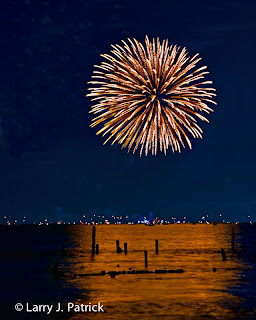Last Friday, I joined about twenty other Bay Area Photo Club members at our monthly field trip to photograph fireworks in Kemah. Neal Kelsoe and Mark Westerman did a great job selecting a great place and providing some instruction on how to do it. The basic instructions included: manual focus at infinity, manual mode, aperture of f/13, bulb shutter speed (2-3 seconds), 50-100mm lens, on a tripod and use of shutter release.
I looked at the field trip as an opportunity to sharpen my skills (which are not that good) at photographing firework. However, when I saw that first firework, my mindset immediately switched to getting a great fireworks photo. Big mistake.
I fired shot after shot without really looking at the display. Finally, I took a little time to see what I had—NOTHING. I generally held the shutter open for 2 to 3 seconds, but that seemed to make the fireworks look blurred. So, I changed my strategy—ISO 1600, aperture f/8 and shutter speed between 1.5 and 2 seconds. Immediately I got better results, or what I thought was better results.
What did I learn from this outing?
 Remember your intentions when the gun goes off—I wanted to improve my skills at photographing fireworks, but my focus was trying to get a great photo. I did not look at my display to get feedback.
Remember your intentions when the gun goes off—I wanted to improve my skills at photographing fireworks, but my focus was trying to get a great photo. I did not look at my display to get feedback.I think that most of the fireworks look best using a shutter speed of 1.5 to 2.0 seconds, so next time, I will probably go shutter speed priority at 1.5 or 2.0 seconds and then look at what I am getting.
Higher ISO allow you to get ambient light that you want. So, dial-in the shutter speed that is best and then select an f-stop that will get you the ambient exposure you want. I look at it similar to using flash photography, but only in reverse.
Here are two of the shots that I liked best.
Enjoy.
Camera settings: Nikon D3, Nikon 28-70mm f/2.8 shot at 70mm, ISO 1,600, f/8 and 1.5 and 1.7 seconds and set white balance to tungsten (to make sky bluer).
Post Processing:
Lightroom—Set black and white points, added clarity and increased contrast.
Photoshop—used spot healing to clean-up various ugly spots.









